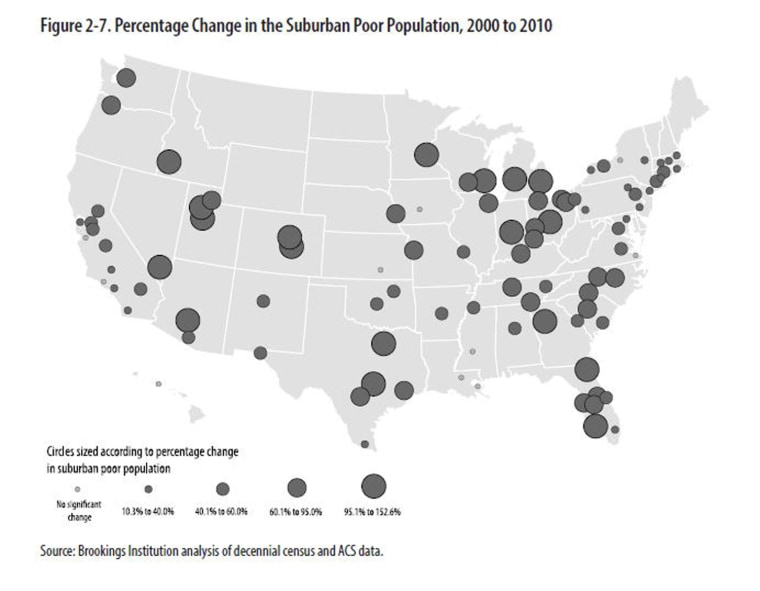When Americans think about poverty, chances are they don’t picture places such as the suburbs surrounding Cape Coral, Fla., Colorado Springs, Colo., and Atlanta.
But a new book, “Confronting Suburban Poverty in America,” finds those were among the suburban areas that saw some of the biggest increases in the number of poor people between 2000 and 2010. The growth was part of a broader shift toward increasing poverty among suburban residents over that decade.
The Brookings Institution book, which was released Monday, detailed the findings the think tank shared with NBC News in March for its report on how poverty has shifted to the suburbs.
The number of suburban residents living in poverty rose by nearly 64 percent between 2000 and 2011, to about 16.4 million people, according to Brookings. That’s more than double the rate of growth for urban poverty in major metropolitan areas, and means that for the first time there were more poor people living in suburbs than in cities.
“I think we have an outdated perception of where poverty is and who it is affecting,” said Elizabeth Kneebone, a fellow at the Brookings Institution and co-author of the research, told NBC News in March. “We tend to think of it as a very urban and a very rural phenomenon, but it is increasingly suburban.”
In the suburbs of Cape Coral, the poverty rate increased by 8 percentage points between 2000 and 2011, to 18.6 percent. In the suburbs surrounding Colorado Springs, the poverty rate increased by 6 percentage points over the 10-year period, to 12.4 percent. In the Atlanta suburbs, it rose 5.9 percentage points to 13.9 percent.
Of course, there are still plenty of metropolitan areas struggling with far higher rates of poverty than their suburban counterparts.
In Grand Rapids, Mich., for example, the poverty rate increased by 14.3 percentage points between 2000 and 2010, to 30 percent. Over that same period, the suburbs of Grand Rapids saw the poverty rate rise by 5.8 percent, to 12.1 percent.
The official release of the Brookings data prompted a number of news outlets to take a look at how poverty demographics have changed in their area.
In Southern California, the Los Angeles Times reported on how the shift in demographics has created tensions in some communities, while the need has been hard to spot in other traditionally well-to-do areas.
In Washington state, The Seattle Times reported on how poverty has sprung up in the south suburbs of Seattle, where immigrants and refugees mix with low-income families who could no longer afford Seattle’s real estate costs.
And in Minnesota, the Star-Tribune explored how a rise in suburban poverty has increased the need for community services such as emergency aid and food assistance in the suburbs of Minneapolis-Saint Paul.
In the Washington, D.C., area National Public Radio detailed how those agencies have struggled to adapt to the changing demographics of poverty, and meet the needs of the suburban poor.
